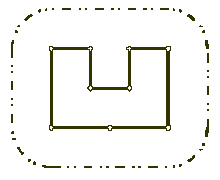POJ 1113 Wall 凸包求周长
来源:互联网 发布:美女网络主播 编辑:程序博客网 时间:2024/05/16 15:07
Wall
Time Limit: 1000MS Memory Limit: 10000KTotal Submissions: 26286 Accepted: 8760
Description
Once upon a time there was a greedy King who ordered his chief Architect to build a wall around the King's castle. The King was so greedy, that he would not listen to his Architect's proposals to build a beautiful brick wall with a perfect shape and nice tall towers. Instead, he ordered to build the wall around the whole castle using the least amount of stone and labor, but demanded that the wall should not come closer to the castle than a certain distance. If the King finds that the Architect has used more resources to build the wall than it was absolutely necessary to satisfy those requirements, then the Architect will loose his head. Moreover, he demanded Architect to introduce at once a plan of the wall listing the exact amount of resources that are needed to build the wall.

Your task is to help poor Architect to save his head, by writing a program that will find the minimum possible length of the wall that he could build around the castle to satisfy King's requirements.
The task is somewhat simplified by the fact, that the King's castle has a polygonal shape and is situated on a flat ground. The Architect has already established a Cartesian coordinate system and has precisely measured the coordinates of all castle's vertices in feet.

Your task is to help poor Architect to save his head, by writing a program that will find the minimum possible length of the wall that he could build around the castle to satisfy King's requirements.
The task is somewhat simplified by the fact, that the King's castle has a polygonal shape and is situated on a flat ground. The Architect has already established a Cartesian coordinate system and has precisely measured the coordinates of all castle's vertices in feet.
Input
The first line of the input file contains two integer numbers N and L separated by a space. N (3 <= N <= 1000) is the number of vertices in the King's castle, and L (1 <= L <= 1000) is the minimal number of feet that King allows for the wall to come close to the castle.
Next N lines describe coordinates of castle's vertices in a clockwise order. Each line contains two integer numbers Xi and Yi separated by a space (-10000 <= Xi, Yi <= 10000) that represent the coordinates of ith vertex. All vertices are different and the sides of the castle do not intersect anywhere except for vertices.
Next N lines describe coordinates of castle's vertices in a clockwise order. Each line contains two integer numbers Xi and Yi separated by a space (-10000 <= Xi, Yi <= 10000) that represent the coordinates of ith vertex. All vertices are different and the sides of the castle do not intersect anywhere except for vertices.
Output
Write to the output file the single number that represents the minimal possible length of the wall in feet that could be built around the castle to satisfy King's requirements. You must present the integer number of feet to the King, because the floating numbers are not invented yet. However, you must round the result in such a way, that it is accurate to 8 inches (1 foot is equal to 12 inches), since the King will not tolerate larger error in the estimates.
Sample Input
9 100200 400300 400300 300400 300400 400500 400500 200350 200200 200
Sample Output
1628
Hint
结果四舍五入就可以了
题目大意:
有一个贪心的国王,他要你的朋友帮他围着他的城堡砌墙,然而他要求你的墙总是隔他的城堡L的距离,并且要求你使用的墙面长度(周长)最小,不然就砍了你朋友。输入给出N个点的坐标构成这个城堡,给出距离L。
解题思路:
大家可以动手画一画给出的样例(很快就画完了)。发现当点 i 和 i+1 和 i+2 是一条直线的时候,也就是两条线段中间不转弯的情况下,我们的周长直接加线段长就好了。但是如果中间出现了转交,那么有两种情况。让我们看看下面的图:
从图中可以看出,如果出现了这样的两个角,那么还不如我们直接砌直线。所以我们可以得出我们构造的最短周长,应该是构造一个凸包。我们的周长就是所有的直线长度加上转角的特殊弧长。弧长怎么算呢?细心一点就知道每个转角对应的圆心角应该是π-内角(我们作城堡直线路径的垂线看看!)。
由此我们再加上这些弧长就是我们的答案了!
代码如下:
#include <iostream>#include <cstdio>#include <algorithm>#include <cmath>using namespace std;#define eps 10e-9#define MAX 1002struct Point { double x,y; Point() {} Point ( double x , double y ) : x(x) , y(y) {}};typedef Point Vector;Point operator - ( Point a , Point b ) { return Point ( a.x - b.x , a.y - b.y ); }bool cmp ( Point a, Point b ) { if ( a.x != b.x ) return a.x < b.x; else return a.y < b.y;}double Length ( Vector v ){ return sqrt ( v.x * v.x + v.y * v.y );}double Dot ( Vector u , Vector v ){ return u.x * v.x + u.y * v.y;}int dcmp ( double x ){ if ( fabs ( x ) < eps ) return 0; else return x < 0 ? -1 : 1 ;}double Distance ( Point a , Point b ){ return sqrt ( ( a.x - b.x ) * ( a.x - b.x ) + ( a.y - b.y ) * ( a.y - b.y ) );}double Cross ( Vector u , Vector v ){ return u.x * v.y - u.y * v.x;}double Angle ( Vector u , Vector v ) { return acos ( Dot ( u , v ) / Length ( u ) / Length ( v ) ); }int ConvexHull ( Point *p , int n , Point *ch ) //求凸包{ int m = 0; sort ( p , p + n , cmp ); for ( int i = 0 ; i < n ; i ++ ) { while ( m > 1 && Cross ( ch[m-1] - ch[m-2] , p[i] - ch[m-2] ) <= 0 ) m --; ch[m++] = p[i]; } int k = m; for ( int i = n - 2 ; i >= 0 ; i -- ) { while ( m > k && Cross ( ch[m-1] - ch[m-2] , p[i] - ch[m-2] ) <= 0 ) m-- ; ch[m++] = p[i]; } if ( n > 1 ) m --; return m;}int main(){ int n,l; Point cas[MAX],ch[MAX]; scanf ( "%d %d" , &n , &l ); for ( int i = 0 ; i < n ; i ++ ) scanf ( "%lf %lf" , &cas[i].x , &cas[i].y ); int cnt = ConvexHull ( cas , n , ch ); double ans = 0; for ( int i = 0 ; i < cnt ; i ++ ) ans += Distance ( ch[(i+1)%cnt] , ch[i] ); for ( int i = 0 ; i < cnt ; i ++ ) { double ang = Angle ( ch[(i+2)%cnt] - ch[(i+1)%cnt] , ch[(i+1)%cnt] - ch[i] ); if ( dcmp ( ang ) != 0 ) { ans += ang * l; } } if ( ans - (int)ans - 0.5 > 0 ) printf ( "%d\n" , (int) ans + 1 ); else printf ( "%d\n" , (int)ans ); return 0;}技巧总结:
凸包在计算几何中占有很重要的地位!
- POJ 1113 Wall 凸包求周长
- POJ 1113 Wall (凸包求周长)
- POJ 1113 Wall (凸包求周长)
- poj 1113 Wall(凸包周长)
- 【解题报告】 POJ 1113 Wall -- 求凸包周长
- POJ 1113 Wall【凸包周长】
- POJ 1113 Wall (凸包周长)
- POJ 1113 Wall(凸包周长)
- POJ 1113 Wall(凸包 多边形周长)
- POJ 1113 Wall(凸包周长)
- POJ 1113 Wall(求凸包周长)
- POJ--1113[Wall] 凸包周长+圆的周长
- POJ 1113 Wall (凸包+求周长)
- nyoj 226 && hdu HDU 1348 && poj 1113 wall [凸包周长]
- POJ 1113 && HDU 1348 Wall (凸包周长 graham扫描法)
- poj 1113 Wall 【求包围所有点、且与所有点距离至少为L的曲线的最小周长】
- POJ 1113 WALL
- POJ 1113 Wall
- Makefile的静态模式
- 在Mac OS X中配置Apache + PHP + MySQL
- 远程 DEBUG tomcat
- 你可能不知道的Shell
- 28个Unix/Linux的命令行神器
- POJ 1113 Wall 凸包求周长
- 整合两个项目
- cigarettes
- UVA 10601 CUBES (正方体Polya,有限制)
- jni编译non-numeric second argument to `wordlist' function错误
- 幸运数——庞果网
- 06-php面向对象编程,静态方法
- Unity3D使用过程中常见的20个问题
- win7下音频采集问题


